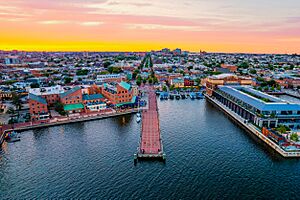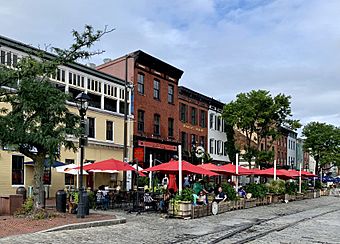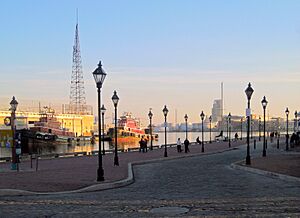Fell's Point, Baltimore facts for kids
Quick facts for kids
Fell's Point
|
|
|---|---|
|
Neighborhood of Baltimore
|
|

The Fell's Point waterfront at sunset
|
|
| Nickname(s):
Fell's/Fells
|
|
| Country | United States |
| State | Maryland |
| City | Baltimore |
| Settled | 1670 |
| Incorporated | 1729 |
| Founded | 1732 |
| Named for | William Fell |
|
Fells Point Historic District
|
|

Storefronts along the Belgian blocks of Thames Street
|
|
| Location | Bounded on the north by Eastern Avenue, on the east by Chester Street, on the south by the Patapsco River and Harbor, and on the west by Central Avenue; southeastern Baltimore, Maryland |
| Area | 75 acres (30 ha) |
| Built | 1763 |
| Architect | Multiple |
| Architectural style | Italianate, Greek Revival |
| NRHP reference No. | 69000319 |
| Added to NRHP | March 28, 1969 |
Fell's Point is a cool, old waterfront neighborhood in southeastern Baltimore, Maryland. It started around 1763 along the Baltimore Harbor. This area is famous for its history with ships and the sea.
You'll find many unique shops here. There are also lots of restaurants, coffee shops, and over 120 pubs. It's a fun place to explore!
For over 250 years, many different groups of immigrants have lived in Fell's Point. These include people from Ireland, Germany, Poland, and more. Since the 1970s, many people have moved here to fix up and save the old homes. Today, the area is a popular place for both residents and tourists.
Fell's Point is a great spot to visit. You can walk there from the Inner Harbor, or take a water taxi. It's one of the first historic districts in the United States. It's also listed on the National Register of Historic Places.
Contents
Discovering Fell's Point History

The area now called Fell's Point was first noted by a European in 1670. It was a small piece of land sticking out into the water. In 1732, a man named William Fell started the town. He liked the deep water and nearby forests, which were good for building ships.
William's son, Edward Fell, began selling land for homes around 1763. The village grew very fast. It later joined with nearby Baltimore Town in 1773 to form the new City of Baltimore.
How Markets Shaped the Town
In 1784, the town added new market areas. One of these was the "Eastern Precincts Market," later called Fells Point Market or Broadway Market. These markets were important gathering places. They helped the area become rich from trading goods like tobacco and coffee.
Shipbuilding and the War of 1812
Fell's Point shipyards were known for building fast ships called "Baltimore clippers." These ships were great for running blockades. They were also used as armed privateer ships. A famous ship, the "Pride of Baltimore II", is based on a clipper built here.
During the War of 1812 (1812-1815), Fell's Point built many privateer ships. These ships attacked British trading vessels. Because of this, Baltimore became a main target for the British. This led to the attack on Fort McHenry in 1814.
A Home for Immigrants
Fell's Point has been an immigrant neighborhood since the 1800s. Many people came here because it was a major entry point into the United States. There were also many jobs in the shipyards and factories. Immigrants lived in affordable homes close to their work. This made the area very diverse.
Frederick Douglass's Time in Fell's Point
In 1835, Frederick Douglass worked at a shipyard in Fell's Point. He was enslaved at the time. In his life story, Douglass wrote that he taught himself to read and write in Fell's Point. He copied letters from boards and made friends with white boys on the street. They helped him learn.
Changes and Challenges
Fell's Point continued to be a shipbuilding center until the American Civil War. After that, ships became too big for the shipyards here. The shipping industry also moved to other places. Fell's Point then became a place for manufacturing, like canning.
The neighborhood was lucky during the Great Baltimore Fire of 1904. This fire destroyed much of downtown Baltimore, but Fell's Point was not badly damaged.
After World War II, many people from rural Appalachia moved to Fell's Point. Later, in the 1960s, many African Americans also settled in the neighborhood.
Saving Fell's Point from a Highway
In the 1960s, there was a plan to build a big highway through Fell's Point. This highway would have destroyed many historic buildings. It would have also cut off the neighborhood from the waterfront.
Local residents fought against this plan. A social worker named Barbara Mikulski helped lead the effort. She later became a U.S. Senator from Maryland. Because of their efforts, Fell's Point was added to the National Register of Historic Places. This helped stop the highway project.
Fell's Point was also a main setting for the 1990s TV show Homicide: Life on the Street. It has also been used for many movies filmed in Baltimore.
In 2003, Hurricane Isabel caused a lot of flooding in Fell's Point. The water was as high as 10 feet in some places.
Exploring Fell's Point Architecture
Fell's Point has many different kinds of old buildings. Some of the oldest homes use a special brick pattern called Flemish bond. There are also many row houses from the 1800s and early 1900s. You can also see buildings with gabled roofs and Victorian styles.
Famous Historic Buildings
- The Robert Long House, built in 1765, is the oldest home still standing in Baltimore.
- Lloyd Street Synagogue, built in 1845, is one of the oldest Jewish synagogues in the United States.
- Saint Patrick Catholic Church, founded in 1792, was damaged in an earthquake in 2011. But it was fixed and reopened in 2012.
Awards and Recognition
In 2012, the American Planning Association named Fell's Point one of the "Great Places in America." This award celebrates places that are special because of their character and good planning.
Fun Annual Festivals
Fell's Point Fun Festival
This festival started in 1966. It was created to help save Fell's Point from the planned highway. The festival helped raise money and awareness about the neighborhood's history. This weekend-long event happens in October. Over 700,000 people attend to enjoy entertainment, crafts, and food.
Fell's Point Privateer Festival
This annual festival in April celebrates the area's history with privateer ships and the sea. It includes educational displays, a pub crawl, and a pet costume contest.
Halloween in Fell's Point
Every October 31st, hundreds of people gather in costumes for Halloween. They take photos, trick-or-treat, and visit the local pubs.
Fell's Point Olde Tyme Christmas Festival
This festival is held in early December. It features a traditional Christmas market, a pet costume contest, and a fun "Reindeer Run" pub crawl.
Who Lives in Fell's Point?
In 2010, about 3,168 people lived in Fell's Point. Most residents were white (61%), followed by Hispanic (24.9%) and African American (7.4%). Many people own their homes here. Most working-age people have jobs.
Famous People from Fell's Point
- Frederick Douglass – A famous leader who fought against slavery.
- Billie Holiday – A legendary Jazz singer.
- Melissa Leo – An actress who won an Academy Award.
- Edith Massey – An actress known for movies by John Waters.
- Michael Phelps – An Olympic gold medal-winning swimmer, who used to live here.





